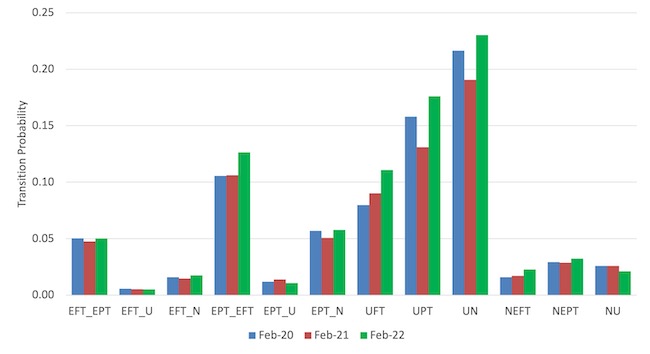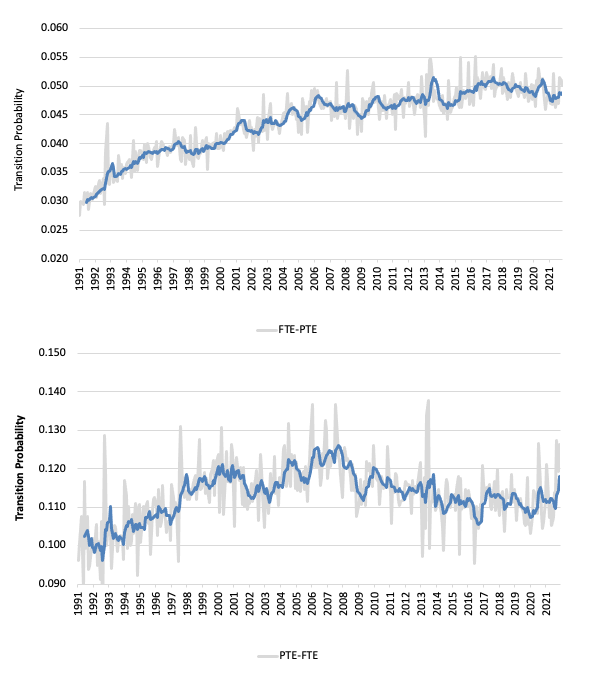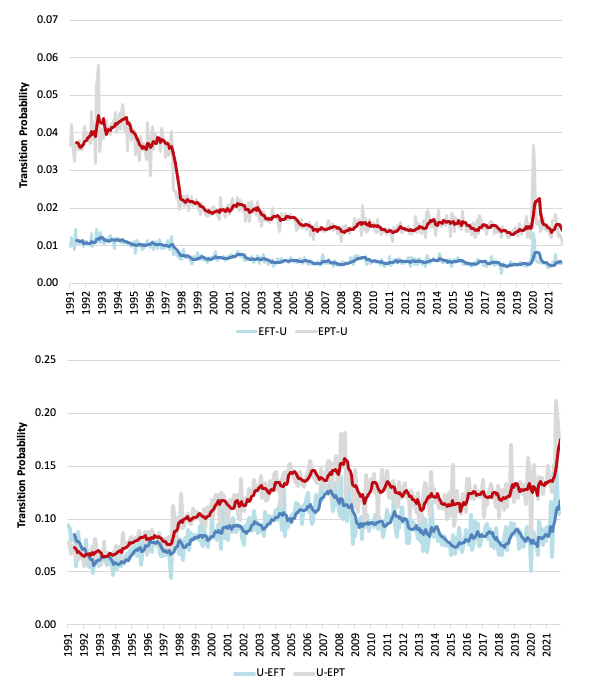I should remind myself not to listen to the media (even the public broadcaster) when…
The chance of an unemployed Australia getting employment now is nearly at highest level since the early 1990s
I was going to comment on the Spring Statement delivered by the British Chancellor yesterday, but Spring is meant to be a happy, sunny time and the Statement missed the mark on that score. I also need to do some more calculations before I really know the full depth of despair that the British government is delivering on its people. So next week. Maybe. But in the spirit of calculation, I wanted to check how easy it is to get a job in Australia at present after hearing some character on the radio yesterday say that it has never been easier. I thought with unemployment getting lower as the external border has been largely shut for 2 years, there might be some credibility in that claim. But one has to check these things and I was interested in whether the border closures have materially altered the transitions between the labour force states. So I updated my databases and went to it. There was some jazz playing in the background to ease the strain! Result: the claim is partially true.
Introduction
Is it getting harder to get a job?
One way of viewing the labour market is in terms of the gross flows that occur each month between the different labour market states.
Just focusing on net results (the usual way of analysing labour force data releases) – such as how much employment changed by obscures the fact that there is continuous flow going on with workers moving between full-time and part-time jobs, unemployment and not in the labour force (that is, non-participation).
The strength of these flows and their direction vary over the economic cycle and the flow dynamics gives us a pretty good view of how things stand.
The only problem is that the data is difficult to deal with, and as a result, the analysis is time consuming.
There is a lot of detailed knowledge you need to have to get into the business of analysing this type of data. If you are interested in reading more go to the Australian Bureau of Statistics resource page – Understanding Movements in Employment – as a starting point.
There are a lot of traps involved. Note these are particular samples drawn out of the labour force survey sample (matched pairs).
The ABS offer the following tips:
In the Labour Force Survey, one-eighth of the dwellings sampled in the previous month are replaced, in the current month, by a new set of dwellings from the same geographic area. The seven-eighth overlap between the dwellings selected in consecutive months maintains continuity within the population survey sample and enables more reliable measurement of change in the labour force characteristics of the population than would be possible if a new sample was introduced each month.
The matching of respondents who report in consecutive months enables analysis of the transition of individuals between the different labour force status classifications, referred to as the matched sample. The transition counts between the different labour force status classifications from one point in time to the next are commonly referred to as gross flows.
And then they offer this warning which tells you that one cannot reconcile the levels that are provided in the LFS data (employment etc) with the totals that appear in the gross flows matrix:
The figures presented in gross flows are presented in original terms only and do not align with published labour force estimates. The gross flows figures are derived from the matched sample between consecutive months, which after taking account of the sample rotation and varying non-response in each month is approximately 80 per cent of the sample.
The major problems in using this data, then, are: (a) sample bias present in any survey data; (b) misclassification errors (likely to be small in ABS labour force data); and (c) rotation group bias (significant issue in ABS labour force data).
You can also read the Abowd, J.M. and Zellner, A. (1985) ‘Estimating Gross Labor-Force Flows’, Journal of Business and Economic Statistics, 3 (3), 254-283 – for further details of these issues.
Gross flows analysis allows us to trace flows of workers between different labour market states (employment; unemployment; and non-participation) between months. So we can see the size of the flows in and out of the labour force more easily and into the respective labour force states (employment and unemployment).
Each period there are a large number of workers that flow between the labour market states – employment (E), unemployment (U) and not in the labour force (N). The stock measure of each state indicates the level at some point in time, while the flows measure the transitions between the states over two periods (for example, between two months).
The net changes each month – between the stock measures – are small relative to the absolute flows into and out of the labour market states.
National statisticians measure these flows in their monthly labour force surveys. The various stocks and flows are denoted as follows (single letters denote stocks, dual letters are flows between the stocks):
- E = employment stock, with subscript t = now, t+1 the next period.
- U = unemployment stock.
- N = not in the labour force stock.
- EE = flow from employment to employment (that is, the number of people who were employed last period who remain employment this period)
- UU = flow of unemployment to unemployment (that is, the number of people who were unemployed last period who remain unemployed this period)
- NN = flow of those not in the labour force last period who remain in that state this period
- EU = flow from employment to unemployment
- EN = flow from employment to not in the labour force
- UE = flow from unemployment to employment
- UN = flow from unemployment to not in the labour force
- NE = flow from not in the labour force to employment
- NU = flow from not in the labour force to unemployment
The following Matrix Table provides a schematic description of the flows that can occur between the three labour force framework states.
The various inflows and outflows between the labour force categories are expressed in terms of numbers of persons which can then be converted into so-called transition probabilities – the probabilities that transitions (changes of state) occur.
We can then answer questions like: What is the probability that a person who is unemployed now will enter employment next period?
So if a transition probability for the shift between employment to unemployment is 0.05, we say that a worker who is currently employed has a 5 per cent chance of becoming unemployed in the next month. If this probability fell to 0.01 then we would say that the labour market is improving (only a 1 per cent chance of making this transition).
From the table above – sometimes called a Gross Flows Matrix – the element EE tells you how many people who were in employment in the previous month remain in employment in the current month.
Similarly the element EU tells you how many people who were in employment in the previous month are now unemployed in the current month. And so on. This allows you to trace all inflows and outflows from a given state during the month in question.
The transition probabilities are computed by dividing the flow element in the matrix by the initial state. For example, if you want the probability of a worker remaining unemployed between the two months you would divide the flow (UU) by the initial stock of unemployment. If you wanted to compute the probability that a worker would make the transition from employment to unemployment you would divide the flow (EU) by the initial stock of employment. And so on.
So the 3 Labour Force states in the Matrix Table above allow us to compute 9 transition probabilities reflecting the inflows and outflows from each of the combinations.
Analysing movements in these probabilities over time provides a different insight into how the labour market is performing by way of flows of workers.
The 9-element labour market flows matrix is the general result. However, the data presented by the Australian Bureau of Statistics (ABS) is quite exceptional in international terms because it splits the employment category into full-time and part-time, adding an extra 7 elements, which are shown in the next table.
The following table shows the schematic way in which gross flows data is arranged by the ABS each month.
Here EFT refers to full-time employment, EPT to part-time employment, U to unemployment and NLF to Not in the Labour Force. The subscripts t and t-1 refer to the current month and the previous month, respectively.
The term matrix might sound technical to those not trained in statistics and algebra, but in this context, think about it as just being a spreadsheet, which almost everyone has a working knowledge of these days.
Each element in the matrix (cell in the spreadsheet) tells you the volume (in 000s for Australian labour force data) of the flows between the different labour force states noted.
So the element EFT to EFT tells you how many people who were in full-time employment in the previous month (t-1) remain in full-time employment in the current month (t).
Similarly the element EFT to U tells you how many people who were in full-time employment in the previous month (t-1) are now unemployed in the current month (t). And so on. This allows you to trace all inflows and outflows from a given state during the month in question.
For example, new entrants to the labour force come from the NLF (Not in the Labour Force) and can transit into EFT, EPT or U. The respect numbers in the relevant cells tell us where these entrants go each month.
This is what the latest gross flows matrix looks like for Australia for transitions between January and February 2022.
Gross flows matrix, January to February 2022 (matched sample)

1. 47.7 thousand person who were unemployed in January 2022 found full-time employment in February 2022, whereas 37.7 thousand persons flowed in the opposite direction.
2. To see how many people dropped out of the labour force or were new entrants in February 2022, we would subtract the sum of the elements (NLF to EFT, NLF to EPT, NLF to U) which are flows from NLF into one of the three labour force categories and then subtract the sum the elements (EFT to NLF, EPT to NLF, U to NLF), which are the flows from the three labour force categories into NLF.
The result is that there were 14.7 thousand persons new entrants into the labour force in the last month.
3. 99.3 thousand previously unemployed persons exited the labour force while 120.9 thousand came into the labour force to become unemployed.
4. 365.9 thousand full-time workers transitted into part-time employment over the month whereas 431.2 part-time workers were able to secure full-time work.
5. According to the official labour force data, total full-time employment rose by 121.9 thousand in February 2022. But that net figure masks the scale of the flows into and out of full-time employment.
The daily flows in and out of these labour force categories is huge relative to the net changes reported each month in the labour force survey.
Total outflows from full-time employment were 364.9 thousand EFT to EPT, 37.7 thousand EFT to U, 128.1 thousand EFT to NLF.
Total inflows were 421.2 thousand EPT to EFT, 47.7 thousand U to EFT, and 129.1 thousand NLF to EFT.
6. The other point to note is that there is clear “state dependence” (which means that flows within same states are the largest).
So EFT to EFT, EPT to EPT, U to U and NLF to NLF (between months) are the largest flow categories. Large numbers of people move between jobs but stay employed in one way or another, and so on.
You can conduct your own analysis as you see fit but the overall impression is clear – the flows between states are substantial even though there is state dependence.
The changing probability of getting a job or becoming unemployed
Here are the latest transition probabilities.
The first graph shows you what is happening to the transition probabilities over the pandemic starting with February 2020.
The graph shows that the over the course of the downturn then ‘recovery’, there is now:
1. A higher transition probability from EPT to EFT, EPT to N, U to EFT, U to EPT, U to N, N to EFT. These shifts are typically signalling an improving labour market for workers.
2. A lower transition probability from EPT to U, and N to U.
3. Part-time workers have a much higher probability of becoming unemployed than full-time workers (more than twice the chance).
Transitions between full-time and part-time employment
In recent months, there has been a stronger full-time employment result, which was in contradistinction to earlier trends indicating that Australia was becoming a part-time employment nation.
The next graph shows the intra-employment transition probabilities (EFT to EPT – upper panel; and EPT to EFT – lower panel) from April 1991 to February 2022. The blue lines in each panel are 6-month moving averages to give a better idea of trend. The light gray series are the seasonally-adjusted original data, which moves around a lot.
You can see that over the last 36 odd years the chances of a full-time worker becoming part-time employed has steadily risen and accelerated following the 1991 recession.
The EFT-EPT transition probability fell sharply in the first months of the pandemic which is probably due to the damage the restrictions placed on part-time working opportunity.
Most full-time workers were probably able to relocate to their home offices.
In the last six months, that downward trend has been reversed.
As the restrictions have eased, it is easier now for part-time workers to gain full-time employment.
Transitions between full-time and part-time employment and unemployment
Finally, the next graph shows the transition probabilities between employment and unemployment (EFT to UN and EPT to UN – upper panel; and U to EFT and U to EPT – lower panel) from April 1991 to February 2022.
The bolder lines in each panel are 6-month moving averages to give a better idea of trend. The lighter series are the seasonally-adjusted original data, which moves around a lot.
You can see that over the last 36 odd years, most of the movements out of employment into unemployment come from the part-time work category, even though that probability has declined with economic growth.
Similarly, there is a much higher probability of an unemployed worker gaining part-time work compared to full-time work.
In the early stages of the pandemic, it was part-time workers who saw their chances of becoming unemployed rise sharply (relative to full-time workers).
In the recovery period, the chances of an unemployed worker gaining both full-time and part-time employment has risen sharply – indicating a strengthening situation.
If you look at the levels of the lower panel we see:
1. The current probability of U to PTE is at its highest level since this dataset began.
2. The probability of gaining full time work for an unemployed person was higher just before the GFC relative to now – 13.4 per cent (January 2008) compared to 11.1 per cent (February 2022).
Conclusion
While the data is quite tricky to work with, the message appears to be that the Australian labour market has improved over the last 6 months.
When assessing the claim that it has never been easier to get a job the conclusion is that it is partially true.
1. A person who is unemployed has the highest chance of getting a part-time job in the record of this data.
2. But not the highest chance of getting a full-time job.
3. I also checked the transitions from Not in the Labour Force into Employment and they are at record high levels.
That is enough for today!
(c) Copyright 2022 William Mitchell. All Rights Reserved.





I wonder if border closing only stopped new migrants from entering host countries, or the people that were already here, found no purpose in staying and left either to other better paying economies or home?
After all, misery in the west might not be that different from misery in the east.
We tend to consider people just beeing another commodity, but there’s a world behind each pair of eyes.
Interesting, wonder how conservatives will spin this? I suppose they will advocate pulling people out of their homes and making them work, short of that they are running out of willing employees. Things will have to contract or wages raise.
In the US we have stopped stimulus, unemployment, and other programs as well as restricted immigration all on the premise of America first and fortress America. Jobs for Americans first. Well…ultra low unemployment and millions checking out of the workforce. They have exhausted most of their tools and are left with shaming and ineffective rate hikes.
Yeah that trickle down and neoliberalism….it’s obsolete.
Off topic question: was there ever a period in history where banks could lend only their reserves?